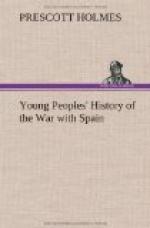[Illustration: Cutting the Cables Under Fire.]
Before we leave the subject of cutting an enemy’s cables, and thus destroying one of their best means of communication, I will tell you of another exploit. The St. Louis, which was one of the big ocean steamships that the Government hired during the war, was the vessel that performed it. A few days after the cables were cut at Cienfuegos, the St. Louis was ordered to Santiago to cut the cables at that point. One very dark night the boats left the big ship and began to grapple for the cables. About three o’clock in the morning they returned with a long piece which they had cut out of one of the cables. About eight o’clock the St. Louis went to work to find the other cable, and after working for three hours, the batteries on shore opened fire on her. They kept up a furious fire for three-quarters of an hour, but the St. Louis replied so vigorously that the batteries were silenced and the garrisons sent running in all directions. Then they found the cable, hauled it on board and cut it. Afterwards the St. Louis cut another cable at San Juan, the capital of Porto Rico.
Do you wonder why these three ports were thought to be the best for the Spanish fleet to enter? You know that Havana is the capital of Cuba; most of the citizens were Spaniards; thousands of Spanish soldiers were there; all the chief officers also. So it was thought that the Spanish Navy would try to unite with the Spanish Army. From Matanzas and from Cienfuegos the troops from the Spanish ships could go easily by railroad to Havana, through a part of the country still in the hands of the Spaniards. I may have told you more than you care to hear about the coming of the enemy’s fleet, but I want to give you an idea of the great anxiety felt by our Government at this time, and to help you to understand what follows. You must remember that we had not vessels enough to blockade every port, so we blockaded the ports that seemed most dangerous.
Where was the Spanish fleet all this time, while our Navy was so troubled? If you look at a map of Cuba you will find that the eastern end of the island—the eastern province—is called Santiago de Cuba. The chief city of the province is on the southern coast, and bears the same name. The city of Santiago is next in importance to Havana, and is said to be the oldest city in the Western Hemisphere.
Santiago is a picturesque city, five miles from the coast. It was founded by Don Diego de Velasquez, who named it for the patron saint of Spain. Santiago, San Diego and St. Jago are really one name, which is translated St. James in our language. The city is built along a sloping hillside, and its massive buildings are tinted pink, blue, green and purple. There are plenty of red-tiled roofs, among which rise towers, steeples and palms. The houses are low and built around courtyards, where flowers and palms grow in profusion. The floors are of brick or marble. There is a plaza, or central square, and a great cathedral. The streets are narrow and dirty, and in the quarters where the poorer class live, babies and pigs roll together in the gutters, and boys and girls without a rag of clothing on them hold out their hands for alms.




